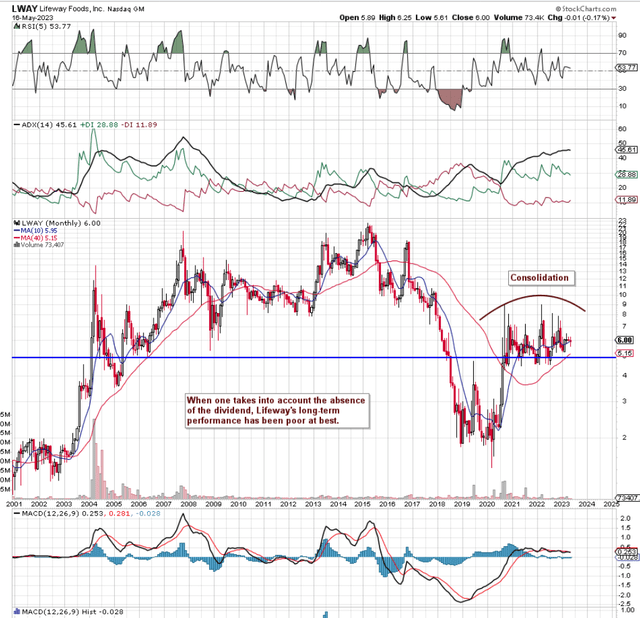Intro
We wrote about Lifeway Foods, Inc. (NASDAQ:LWAY) back in August of 2021 when we stated that the probiotic manufacturer was due for a rally off its pending lows. The company had plenty going for it at the time which resulted in a record-breaking year in fiscal-2022 with respect to reported top-line sales ($141.6 million). Although LWAY stock did eventually bottom some months after our commentary, we were expecting more than the 11% return we have seen in the interim period.
Suffice it to say, if we bring up a long-term chart of Lifeway Foods, we see that shares have actually consolidated over the past couple of years where the majority of trading has taken place between $5 and $7 per share. Whether this consolidation continues is an unknown at this point but long-term investors (despite strong near-term growth numbers) would do well to study Lifeway’s share-price trajectory over past decades. For example, one’s 20-year return could actually be close to 0% (in nominal terms but negative in real terms when adjusted for inflation) considering one could have bought this stock 20 years ago in 2003 for roughly $6 a share (what Lifeway is trading at today).

LWAY Technical Chart (Stockcharts.com)
This exercise is important for a few reasons. Firstly, history many times repeats in financial markets because human psychology tends in the main not to change. For example, Lifeway Foods is doing very well at present because customers are well-versed in the benefits of the company’s core ‘Kefir’ product offerings. The benefits of probiotics, vitamin D as well as protein are clearly evident which means this product line has been marketed excellently to date.
In fact, in the recent first quarter of 2023 where sales jumped by 11%+ (now 14 consecutive quarters of quarterly top-line growth), we saw that Lifeway Foods continues to take advantage of three principal trends which continue to boost the company’s earnings. These are higher volumes of products sold, higher realized prices due to price increases, and lower inflation which is beginning to decrease costs on the income statement and consequently increase margins.
However, Lifeway’s long-term chart is a strong reminder that present momentum may not have longevity which is why sustained earnings growth needs to come off those growing sales in earnest. Buying stocks based on the latest market trends is risky because we essentially do not know how long the present trend will last. While management fully intends to make hay while the sun shines (by introducing Kefir products to as many prospects as possible), the astute investor would still be eyeing up potential headwinds (such as sustained inflation or a sentiment shift in the health & wellness space) as to how this would affect the stock of Lifeway.
Pricing Power Uncertainty
For example, in a sustained high-inflation environment, could management continue to increase its prices without volumes being affected? Warren Buffett to this point said the following.
“The single most important decision in evaluating a business is pricing power. If you’ve got the power to raise prices without losing business to a competitor, you’ve got a very good business. And if you have to have a prayer session before raising the price 10 percent, then you’ve got a terrible business.”
The best indicator of pricing power is the trend of a company’s gross margin. Lifeway’s trailing 12-month gross margin comes in at 21.9% whereas the stock’s 5-year average gross margin comes in at a higher 26.8%. Suffice it to say, although margins have been rising over the near term, history tells us that this trend may indeed not continue.
In fact, Lifeway’s trailing net profit margin (although rising) comes in at a very low 1.84% which needs to be watched for the following reason. If we were to round some numbers up for example, Lifeway at present makes $0.22 in gross profit and $0.02 in net profit for every $1 of reported top-line sales. Now if inflation remains elevated and costs were to rise once more, management would need to continue to increase the prices of its products in order to have no loss in earnings over time. Would this be possible considering how Lifeway’s gross margin is trending? On the contrary, if management felt it could not carry out a raft of price increases, that 1.84% net profit margin would quickly fall closer to negative territory which obviously is a trend investors would not like to see.
Conclusion
Therefore, to sum up, Lifeway’s recent fourth-quarter report in March of this year as well as its recent Q1 report in May did little to move the share price despite the continued sequential quarterly top-line growth in the company. Margins remain tight and earnings revisions for fiscal 2023 have begun to come under pressure. Although milk prices have stabilized somewhat in recent months, risks persist here if transportation costs were to gain traction once more. Let’s see what Q2 brings. We look forward to continued coverage.
Editor’s Note: This article covers one or more microcap stocks. Please be aware of the risks associated with these stocks.
Read the full article here










